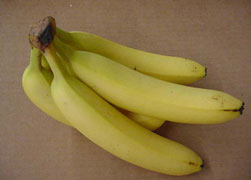


Home
Flowers &
Indoor Plants
Fruits & Nuts
Ornamentals
Vegetables
Special Topics
Resources
Glossary

 |
What about it? Native to India and China, the banana was cultivated and improved by aborigines before historic time. At that time, the fruit was so full of seeds that there was barely any edible flesh. Bananas were quite popular with the ancients and today no other fruit is more widely known and valued, both as a food staple in the Tropics and as a dessert fruit of tropical and temperate climates. What is it used for? In the United States the banana is eaten as a dessert or snack or used in baking. In the Tropics a variety of the banana, known as the Plantain banana, is used unripe as a baked or boiled vegetable or dried and ground into flour. Where does it grow? How do we grow it? Bananas are commonly grown in the tropics. It is, however, possible to grow bananas in the United States under the right conditions. Bananas are found in some of the Southern states, including Florida, Alabama, Georgia, Louisiana, and Texas. The secret is to plant bananas where they have a continual source of water - and some protection from cold northeast winds. Bananas should be grown on well-drained, fertile soil with good moisture retention. A flat terrain is best for growing bananas. What are its primary problems? Panama disease, also known as banana wilt, is one of the world's most catastrophic plant diseases and is common in banana plantations. It is spread by infected soil, tools, and water. Sigatoka disease, also called leaf spot, is now by far the most serious disease of banana, causing premature death of large areas of the plant's leaf surface. Several nematodes can be problematic to bananas, as well as the banana weevil. How do we harvest and store it? For home consumption the bunch is left hanging until the fingers are 'full' (rounded). The weight of the bunch increases considerably during the last two or three weeks and it is to the farmer's advantage to postpone cutting as long as possible. On the other hand, a full bunch is very vulnerable in transport; the longer this will take, the sooner the bunch must be cut. For export and transport overseas the bunch is cut before it is fully ripe; that is why we sometimes see slightly-green bananas in the grocery stores. Bananas are shipped in refrigerated cargo holds on ships. In the port of destination the fruit is unloaded and taken to specially constructed banana ripening rooms.
© Copyright, Department of Horticulture, Cornell University. |


